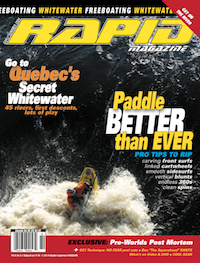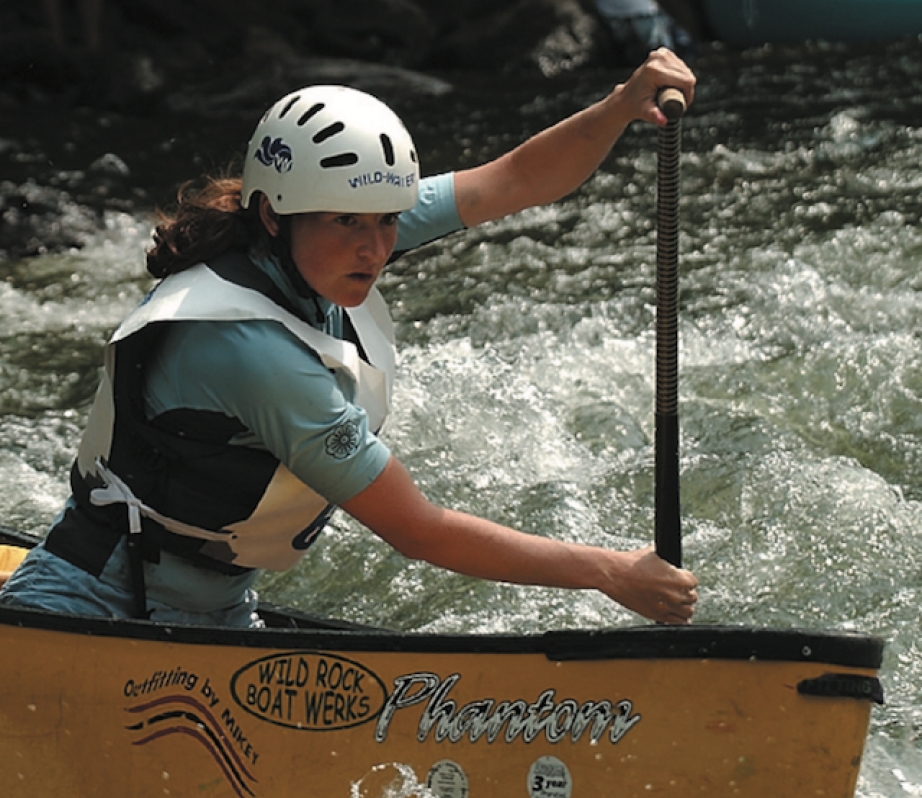Dear Rapid,
It was hot and deserted at the Gull River yesterday. I sat in the eddy across from the bridge and stared at the water bottle between my knees. The acrid bile of self-pity swamped me. If anyone had offered me a thousand bucks for my miserable Dagger Phantom, they would have had themselves a deal.
All the “intermediate” paddlers I know are afraid to exit an eddy with their paddle on their offside. As a result they, like me most days, only paddle half the river. We all gingerly exit with an onside pry that somewhat slows (and somewhat controls) the opening of angle. The offside exit is the hurdle that all open boaters face. A friend told me last night that an offside is 50- percent mental. I wept.
What if I’m just doing something wrong, what if there’s some secret that’s eluded me, some magic way of thinking to restore that fleeting sense of offside balance that visits and then leaves like some fickle angel. Will we all have to sell our boats and take up golf?
Yours on a pry, Phobic
Dear Phobic,
The pry eddy turn is a lot of fun in a “what the hell” kind of way on a warm day. For a stronger stroke, try the cross-draw instead. It is more stable, makes it easier to control the angle of attack and maintain forward momentum, and I think it is easier to learn. It’s just better.
Here is a quick tip that might help. Rotate to your offside from your hips and not just your shoulders or upper back. Planting your paddle on the offside properly forces you to rotate your shoulders and upper back. Rotating your hips as the paddle crosses the bow will keep you balanced when you plant the blade. Lots of tilt will make it more comfortable to rotate and reach and will stabilize your turn.
I know that some people teach the cross-draw with the top hand back and blade forward, but I prefer (even for beginners) to plant the cross-draw with the shaft vertical. Your arms should be almost straight. Your shoulders and the paddle shaft should form an isosceles triangle. Plant the blade so it is perpendicular to the current. As the turn progresses, rotate the blade so it stays perpendicular to the current. A vertical paddle shaft is more stable, causes less risk of shoulder injury and is more powerful and quicker to transition to a cross-forward stroke at the end of your turn.
Mark Scriver—coauthor of Thrill of the Paddle and former OC1 freestyle world champion.
Dear Phobic,
It’s amazing that we want to do offside peel-outs into rapids with names like Valley of Death and Widow Maker. Not exactly confidence-inspiring. So, for us that means finding some flatwater to practice accelerating from a standstill and then carving offside circles using cross-forward strokes and consistent leans. Do a range of tilts from almost flat to an extreme tilt.
Then, on a very easy stretch of river, back up in eddies so you can confidently accelerate across eddylines with short, powerful forward and cross- forward strokes and well-earned rock-solid leans. Don’t use a static cross-draw to do peel-outs; keep your
paddle moving with short, aggressive, well-timed cross-forward strokes. You’ll be much more stable while letting the current turn your boat for you. Have a look at Kent Ford’s Solo Playboating video and workbook.
Allyson Phillips and Roger Warnatsch—RCABC Instructors.
Dear Phobic,
While your friend is absolutely right that it’s largely a psych move, we as sentient beings can find physics and logic to combat our primal fear. Let’s assume you’re doing the stroke correctly.
As we know, placing the blade in the water, as well as momentum, provide us with stability. Consider the direction of the current and the eddyline while you’re sitting in an eddy. If you’re starting your momentum and your offside stroke by placing your paddle blade in the swirly, inconsistent water of the eddyline, chances are you will feel less stable, and it will be difficult to gain the stability of momentum if you are unable to generate it. Make sure that you start in the part of the eddy where the water is moving upriver—this willprovide a “meaty” spot to plant strokes and start your manoeuvre.
Beth Kennedy—ORCA Moving Water Instructor course director, three-time medalist at U.S. Open Canoe Slalom Nationals.
Phobic,
Recently, I raced a slalom course where the eddy was a moving eddy and the eddyline was very boily. The upstream gate was placed right on the eddyline. The only way for me to leave the eddy without touching the gate was to leave on my offside. Leaving on my offside was the last thing I wanted to do. During practice, every time I left on my onside, I would get bounced back into the eddy because with a pry I didn’t have enough angle and speed. During the race, I found the courage to power up and leave the eddy, all on my offside. Not only did the stroke feel incredibly powerful, I didn’t touch the gate. Just before crossing the eddyline, I dug my paddle in and pulled hard. At the end of the stroke, Ieaned back to keep the bow out of the faster current, kept the boat fairly flat and committed to it.
Vanessa Charron—Instructor, wilderness river paddler and two-time North American Whitewater Slalom Tandem Canoe co-Champion.
Dear Phobic,
As an intructor, I often see stability as the root problem canoeists have with their offside moves. Stability is based on the relationship between your boat and the water surface. But, it is you who controls canoe stability.
To master this skill you can play “Simon says” while paddling. Simon says, “Always freeze your legs prior to crossing an eddyline.” By locking your legs in the thigh straps, you can control the tilt of the canoe and prevent boat wobbles and flips during turns to your offside. This may sound easy enough, but remember while your legs are frozen your upper body has to do some funky offside strokes. It takes practice to get those legs working for you, but it will certainly help stabilize the canoe.
Phobic, you also have control over the stability of the water. If you are sitting in an eddy pool and wish to exit into the current, it’s your choice to enter stable or unstable water. Here is how it works. Beside the eddy pool there will be waves. These waves have crests and troughs. The most stable point to enter the current is at the wave trough. Here, the shape of the wave will cradle the canoe and actually surf you away from the eddy pool. Angle is import for this to work, but don’t worry, Phobic, it is easy to figure out. You won’t require much tilt and the resulting surf will help maintain your speed. Best of all, you will be on a stable part of the wave—a good place from which to initiate a turn and use your cross-strokes.
Andrew Westwood—instructor at Madawaska Kanu Centre, Esquif team member, Rapid OC technique columnist.





